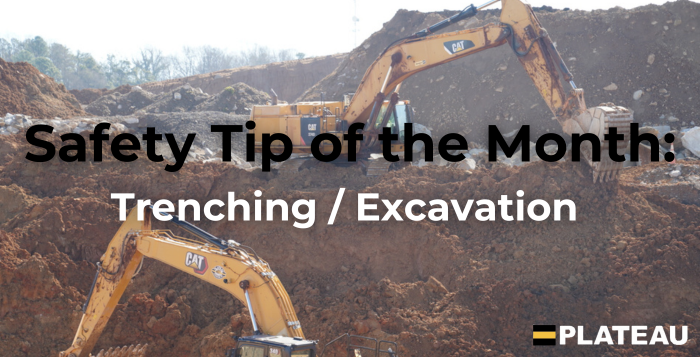Plateau Excavation

Trenching/Excavation
Hazards of trench/excavation:
- Cave-ins pose the most significant risk and are more likely than other excavation-related incidents to result in worker fatalities.
- Falling loads (dirt/rocks)
- Hazardous atmosphere
- Hazards from equipment working on/in the trench
Procedures to avoid injuries:
- Trenches must be inspected by a competent person daily and before the start of work, after any weather event, and as needed throughout the day.
- Must locate existing underground utility lines before we start digging.
- Any trench or excavation must be sloped at a minimum of 1 ½: 1.
- If slopes cannot be obtained, employees shall be protected by an adequate protective system (trench box, hydraulic shoring).
- A copy of the tabulated data for trench box/protective systems must be maintained at the project while in use.
- Employees shall be protected from excavated or other materials or equipment that could pose a hazard by falling or rolling into excavations. Protection shall be provided by placing and keeping such materials or equipment at least four feet from the edge of the excavation.
- A ladder must be located within 25’ of employees working in a trench and inspected before use.
- No employee is permitted underneath loads being lowered into the excavation. Employees must exit the excavation to avoid being struck by any spillage or falling materials.
- PPE must be worn at all times (hard hat, High Vis safety vest, gloves, safety glasses, and hard-soled boots with ankle support).
- Employees are not permitted to work in excavations that contain or are accumulating water unless precautions have been taken to protect them from the hazards posed by water accumulation. Precautions may include special support or shield systems to protect from cave-ins, water removal to control accumulating water, or safety harnesses and lifelines.
“Excavations are one of the most dangerous things we do daily. We must follow our policies and procedures at all times. We must never take a shortcut or become complacent. It takes everyone’s full commitment to doing things correctly and safely every second of the day to ensure everyone goes home safely to their families. We will always do everything in our power to make sure that happens. I know it has been a very hot summer, and I appreciate the dedication and commitment you all have given to our projects’ safety. Thanks.” – Joseph Dudley, Corporate Director of Safety